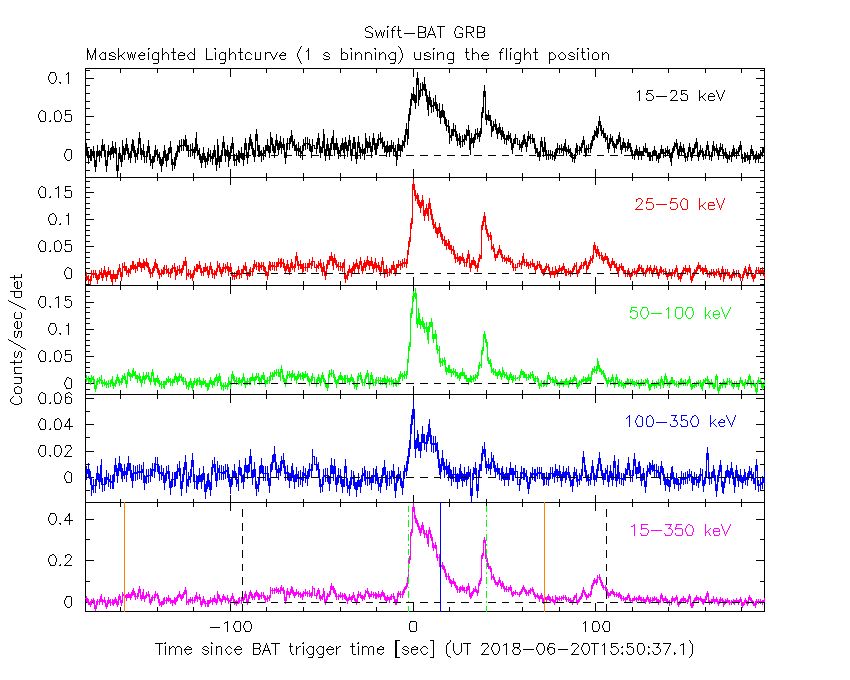
P.A. Evans (U. Leicester), A. Melandri (INAF-OAB) and A.A. Breeveld (UCL-MSSL) for the Swift team
At 15:50:37 UT, the Swift Burst Alert Telescope (BAT) triggered and located GRB 180620B (trigger=843211) (Evans et al. GCN Circ. 22807). Swift slewed immediately to the burst. At the time of the trigger, the initial BAT position was 110° from the Sun (6.1 hours West) and 125° from the 53%-illuminated Moon. Table 1 contains the best reported positions from Swift, and the latest XRT position can be viewed at http://www.swift.ac.uk/xrt_positions.
Evans et al. (GCN Circ. 22807) reported the discovery with UVOT of an optical afterglow. Schweyer and Schady (GCN Circ. 22819) reported the position from GROND for the optical afterglow of this GRB. Izzo et al. (GCN Circ. 22823) determined a redshift of 1.1175 from VLT. Table 2 is a summary of GCN Circulars about this GRB from observatories other than Swift.
Standard analysis products for this burst are available at https://gcn.gsfc.nasa.gov/swift_gnd_ana.html.
As reported by Ukwatta et al. (GCN Circ. 22821),
the BAT ground-calculated position is RA, Dec = 357.514, -57.954 deg which is RA(J2000) = 2
The mask-weighted light curve (Figure 1) shows a multi-peaked structure that starts at ~T-160 s and ends at ~T+160 s.
The three main peaks occur at ~
The time-averaged spectrum from T-159.376 to T+162.428 s is best fit by a power law with an exponential cutoff.
This fit gives a photon index 1.30 ± 0.20, and
The results of the batgrbproduct analysis are available at https://gcn.gsfc.nasa.gov/notices_s/843211/BA/.
Analysis of the initial XRT data was reported by Melandri et al. (GCN Circ. 22817). We have analysed 25 ks of XRT data for GRB 180620B, from 89 s to 436.0 ks after the BAT trigger. The data comprise 237 s in Windowed Timing (WT) mode with the remainder in Photon Counting (PC) mode. The enhanced XRT position for this burst was given by Beardmore et al. (GCN Circ. 22814).
The late-time light curve (Figure 2) (from T0+4.3 ks) can be modelled with an initial power-law decay with an index of α=0.58 (+0.11, -0.08), followed by a break at T+39.1 ks to an α of 1.05 ± 0.09.
A spectrum formed from the WT mode data can be fitted with an absorbed power-law with a photon spectral index of 2.25 ± 0.04. The best-fitting absorption column is 6.3 (+0.5, -0.4) x 1
A summary of the PC-mode spectrum is thus:
Galactic foreground: 1.4 x 1
Intrinsic column: 4.4 (+1.0, -0.9) x 1
Photon index: 1.93 ± 0.09
The results of the XRT team automatic analysis are available at http://www.swift.ac.uk/xrt_products/00843211.
The Swift/UVOT began settled observations of the field of GRB 180620B 92 s after the BAT trigger
(Breeveld et al. GCN Circ. 22827).
A source consistent with the enhanced XRT position (Beardmore et al., GCN Circ. 22814) and the Grond position (Schweyer and Schady, GCN Circ. 22819), and also detected by Izzo et al. (GCN Circ. 22823) is detected in the initial UVOT exposures in all filters except uvw2.
Table 3 gives preliminary
magnitudes using the UVOT photometric system
(Breeveld et al. 2011, AIP Conf. Proc., 1358, 373).
No correction has been made for the expected extinction in the Milky Way
corresponding to a reddening of

Figure 1. The BAT
mask-weighted light curve in the four individual and total
energy bands. The units are counts

Figure 2. The XRT light curve.
Any data from a crosshatched region are not included in the fit.
| RA (J2000) | Dec (J2000) | Error | Note | Reference |
|---|---|---|---|---|
| 2 |
-57°57'44.1" | 0.75" | UVOT-initial | Evans et al. GCN Circ. 22807 |
| 2 |
-57°57'44.8" | 1.4" | XRT-final | UKSSDC |
| 2 |
-57°57'44.8" | 1.4" | XRT-enhanced | Beardmore et al. GCN Circ. 22814 |
| 2 |
-57°57'13.5" | 1.0' | BAT-refined | Ukwatta et al. GCN Circ. 22821 |
| Band | Authors | GCN Circ. | Subject | Observatory | Notes |
|---|---|---|---|---|---|
| Optical | Schweyer and Schady | 22819 | GROND observations | GROND | detection |
| Optical | Izzo et al. | 22823 | VLT/X-shooter redshift | VLT | redshift |
| Gamma-ray | Mailyan | 22813 | Fermi GBM detection | Fermi GBM | Fluence=7.7±0.04x1 (6 |
| Gamma-ray | Svinkin et al. | 22825 | Konus-Wind observation | Konus-Wind | Duration=~260 seconds Fluence=1.19(-0.12,+0.14)x1 |
| Gamma-ray | Sharma et al. | 22844 | AstroSat CZTI detection | CZTI |
| Filter | Exp(s) | Mag | ||
|---|---|---|---|---|
| white | 92 | 242 | 147 | 18.06 ± 0.08 |
| v | 634 | 826 | 39 | 17.41 ± 0.22 |
| b | 559 | 579 | 20 | 17.56 ± 0.18 |
| u | 304 | 554 | 246 | 17.40 ± 0.09 |
| uvw1 | 9950 | 18219 | 1394 | 20.17 ± 0.2 |
| uvm2 | 6563 | 16382 | 804 | 20.6 ± 0.3 |
| uvw2 | 4256 | 4443 | 183 | > 19.7 |
Table 3. UVOT observations reported by Breeveld et al. (GCN Circ. 22827). The start and stop times of the exposures are given in seconds since the BAT trigger. The preliminary detections and 3-σ upper limits are given. No correction has been made for extinction in the Milky Way.
June 26, 2018